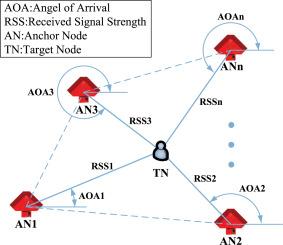A weighted hybrid indoor positioning method based on path loss exponent estimation
IF 4.4
3区 计算机科学
Q1 COMPUTER SCIENCE, INFORMATION SYSTEMS
引用次数: 0
Abstract
With the rapid development of the Internet of Things (IoT), location-based services (LBS) have gained significant attention due to their widespread applications in daily life. This paper addresses the indoor target positioning problem in wireless sensor networks (WSNs). A weighted constrained linear least squares algorithm based on path loss exponent estimation (PLE-WCLLS) with received signal strength (RSS) and angle of arrival (AoA) hybrid measurements is proposed. To address the challenges of unknown transmission power and path loss exponent (PLE), the proposed method employs a linear least squares (LLS) estimation approach based on the ranging maximum likelihood (ML) estimation model to estimate both parameters. Subsequently, a confidence weight adjustment strategy is designed to reduce positioning errors. To handle the highly non-convex and nonlinear nature of the RSS/AoA hybrid optimization model, a linearization method based on Taylor series expansion is presented. Accurate target position estimation is achieved by solving a constrained quadratic programming problem. The effectiveness of the proposed algorithm is validated through numerical simulations and experimental evaluation in a real indoor environment. Compared to traditional positioning methods, the PLE-WCLLS algorithm improves positioning accuracy by 13.2%, and it performs exceptionally well even in scenarios with fewer sensor nodes. This gives it broad application prospects in areas such as IoT device management, personnel tracking in smart buildings, and asset localization in industrial automation.

基于路径损耗指数估计的加权混合室内定位方法
随着物联网(IoT)的快速发展,基于位置的服务(LBS)因其在日常生活中的广泛应用而备受关注。本文探讨了无线传感器网络(WSN)中的室内目标定位问题。本文提出了一种基于接收信号强度(RSS)和到达角(AoA)混合测量的路径损耗指数估计(PLE-WCLLS)的加权约束线性最小二乘法算法。为了应对未知传输功率和路径损耗指数(PLE)的挑战,所提出的方法采用了基于测距最大似然(ML)估计模型的线性最小二乘(LLS)估计方法来估计这两个参数。随后,设计了一种置信度权重调整策略,以减少定位误差。为了处理 RSS/AoA 混合优化模型的高度非凸和非线性性质,提出了一种基于泰勒级数展开的线性化方法。通过求解约束二次编程问题,实现了精确的目标位置估计。通过数值模拟和真实室内环境的实验评估,验证了所提算法的有效性。与传统的定位方法相比,PLE-WCLLS 算法的定位精度提高了 13.2%,即使在传感器节点较少的情况下也表现出色。这为它在物联网设备管理、智能建筑中的人员跟踪和工业自动化中的资产定位等领域带来了广阔的应用前景。
本文章由计算机程序翻译,如有差异,请以英文原文为准。
求助全文
约1分钟内获得全文
求助全文
来源期刊

Ad Hoc Networks
工程技术-电信学
CiteScore
10.20
自引率
4.20%
发文量
131
审稿时长
4.8 months
期刊介绍:
The Ad Hoc Networks is an international and archival journal providing a publication vehicle for complete coverage of all topics of interest to those involved in ad hoc and sensor networking areas. The Ad Hoc Networks considers original, high quality and unpublished contributions addressing all aspects of ad hoc and sensor networks. Specific areas of interest include, but are not limited to:
Mobile and Wireless Ad Hoc Networks
Sensor Networks
Wireless Local and Personal Area Networks
Home Networks
Ad Hoc Networks of Autonomous Intelligent Systems
Novel Architectures for Ad Hoc and Sensor Networks
Self-organizing Network Architectures and Protocols
Transport Layer Protocols
Routing protocols (unicast, multicast, geocast, etc.)
Media Access Control Techniques
Error Control Schemes
Power-Aware, Low-Power and Energy-Efficient Designs
Synchronization and Scheduling Issues
Mobility Management
Mobility-Tolerant Communication Protocols
Location Tracking and Location-based Services
Resource and Information Management
Security and Fault-Tolerance Issues
Hardware and Software Platforms, Systems, and Testbeds
Experimental and Prototype Results
Quality-of-Service Issues
Cross-Layer Interactions
Scalability Issues
Performance Analysis and Simulation of Protocols.
 求助内容:
求助内容: 应助结果提醒方式:
应助结果提醒方式:


